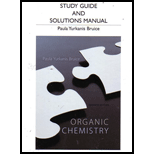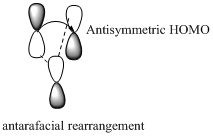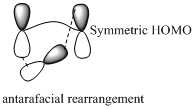
Concept explainers
Interpretation:
It should be determined that the given [1, 7] sigmatropic rearrangement involves whether suprafacial or antarafacial rearrangement.
Concept introduction:
In a sigmatropic reaction “ one new sigma-bond is formed as another breaks.”

Sigmatropic rearrangement reactions are named with digits. For example a [1, 3] sigmatropic rearrangement describe a reaction in which the residue migrates from position 1 to position 3.
Migration of carbon and hydrogen will occur in a sigmatropic rearrangement reaction.
When hydrogen migrates in a sigmatropic rearrangement, the s orbital of the hydrogen is partially bonded to both the migration origin and the migration terminus in the transition state.
Migration of hydrogen in suprafacial and antarafacial rearrangement can be represented as follows,


Migration of carbon occurs through two ways because it has a two lobed p orbital. Carbon can simultaneously interact with the migration origin and the migration terminus using one lobe of its p orbital. Migration of carbon in suprafacial and antarafacial rearrangement can be represented as follows,
Carbon migrating with one lobe of its p orbital interacting


Carbon migrating with both lobe of its p orbital interacting


Trending nowThis is a popular solution!

Chapter 28 Solutions
Organic Chemistry
- One of the steps in fatty-acid biosynthesis is the dehydration of (R)-3-hydroxybutyryl ACP to give trans-crotonyl ACP. Does the reaction remove the pro-R or the pro-S hydrogen from C2?arrow_forwardAssign R or S configurations to each stereogenic center of isoborneol and borneol. Give the relationship between these two stereoisomers.arrow_forwardHow many stereocentres are present in 2‑bromoethan‑1‑ol?arrow_forward
- The relative configurations of the stereoisomers of tartaric acid were established by the following syntheses:(1) d@(+)@glyceraldehyde T diastereomers A and B (separated)(2) Hydrolysis of A and B using aqueous Ba(OH)2 gave C and D, respectively.(3) HNO3 oxidation of C and D gave (-)@tartaric acid and meso-tartaric acid, respectively.(a) You know the absolute configuration of d-(+)-glyceraldehyde. Use Fischer projections to show the absolute configurations of products A, B, C, and D.(b) Show the absolute configurations of the three stereoisomers of tartaric acid: (+)-tartaric acid, (-)-tartaric acid, andmeso-tartaric acid.arrow_forwardWhat are the stereochemical descriptors for mannose and fucose in the above scheme? 1. Both are d-sugars. 2. Both are l-sugars. 3. Mannose is d and fucose is l. 4. Mannose is l and fucose is d.arrow_forwardThreonine has two asymmetric centers and, therefore, has four stereoisomers. Naturally occurring l-threonine is (2S,3R)-threonine. Which of the following stereoisomers is l-threonine?arrow_forward
- (S)-Lactic acid has a specic rotation of +3.8. (a) If the ee of a solution of lactic acid is 60%, what is [a] for this solution? (b) How much of the dextrorotatory and levorotatory isomers does the solution contain?arrow_forwardConsider a mixture that is 60% (+) enantiomer and 40% (-) enantiomer. In which direction will the mixture rotate plane-polarized light? What is the enantiomeric excess of the mixture?arrow_forwardWhat is the ee for each of the following mixtures of enantiomers A and B?a. 95% A and 5% Bb. 85% A and 15% Barrow_forward
- 3b) (i) Using Fischer projection, draw all the stereoisomers of 3-chloro-2-hydroxypentanoic acid. ii) Assign the chiral centre(s) with R/S configurations in part (b)(i). Indicate which areenantiomers, diastereomers and meso compounds (if any).arrow_forwardMetabolism of arginine produces urea and the rare amino acid ornithine. Ornithine has an isoelectric point close to 10.Propose a structure for ornithinearrow_forwardPerform a stereochemical analysis of the final hydrobenzoin product, indicating which pairs are enantiomers and/or diastereomers, or a meso compound. Indicate the chiral centres with asterisks(*) and assign the stereochemical configuration at each chiral centre. Then indicate the stereochemical relationship between each stereoisomerarrow_forward

 Organic ChemistryChemistryISBN:9781305580350Author:William H. Brown, Brent L. Iverson, Eric Anslyn, Christopher S. FootePublisher:Cengage Learning
Organic ChemistryChemistryISBN:9781305580350Author:William H. Brown, Brent L. Iverson, Eric Anslyn, Christopher S. FootePublisher:Cengage Learning

